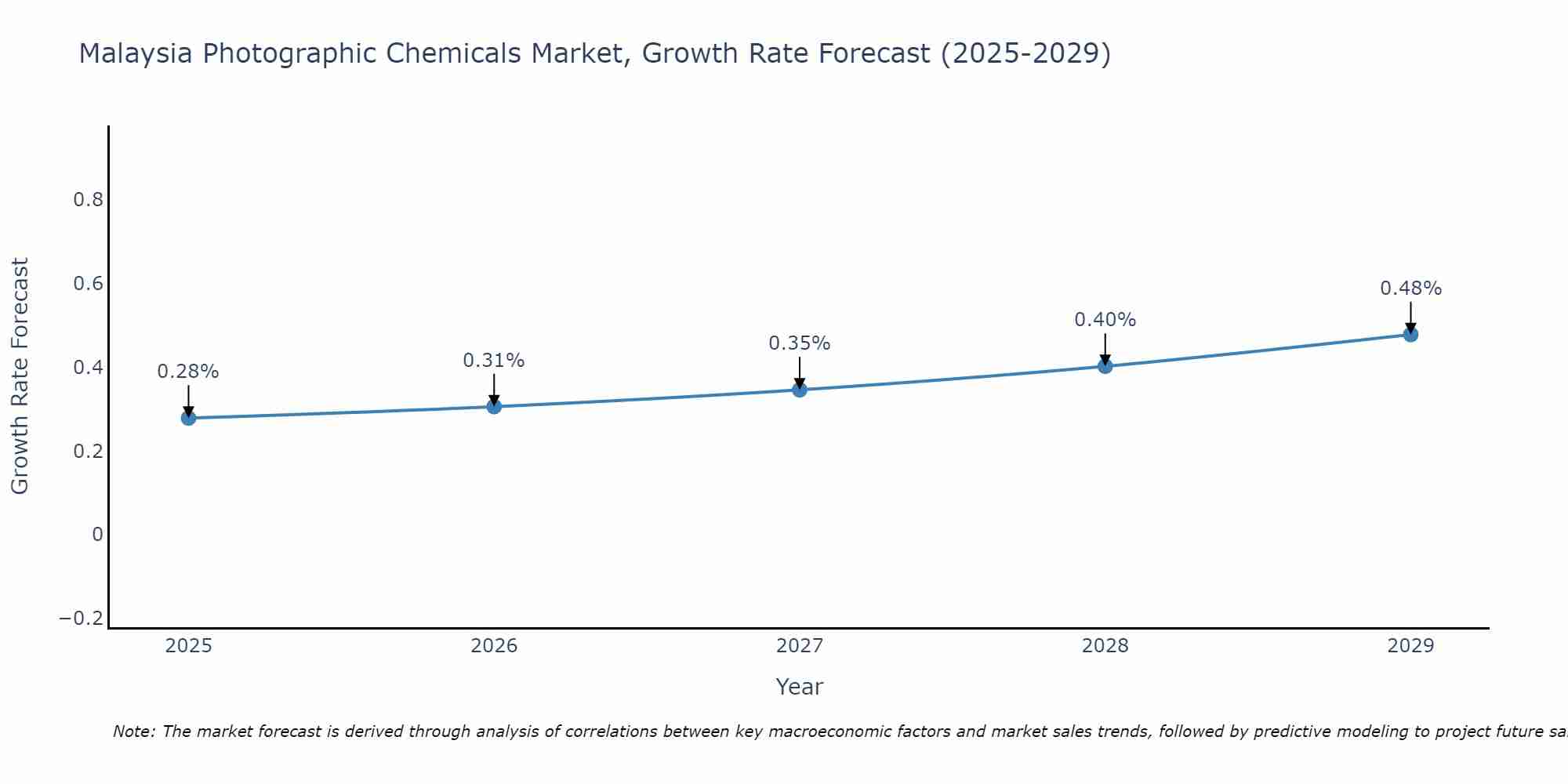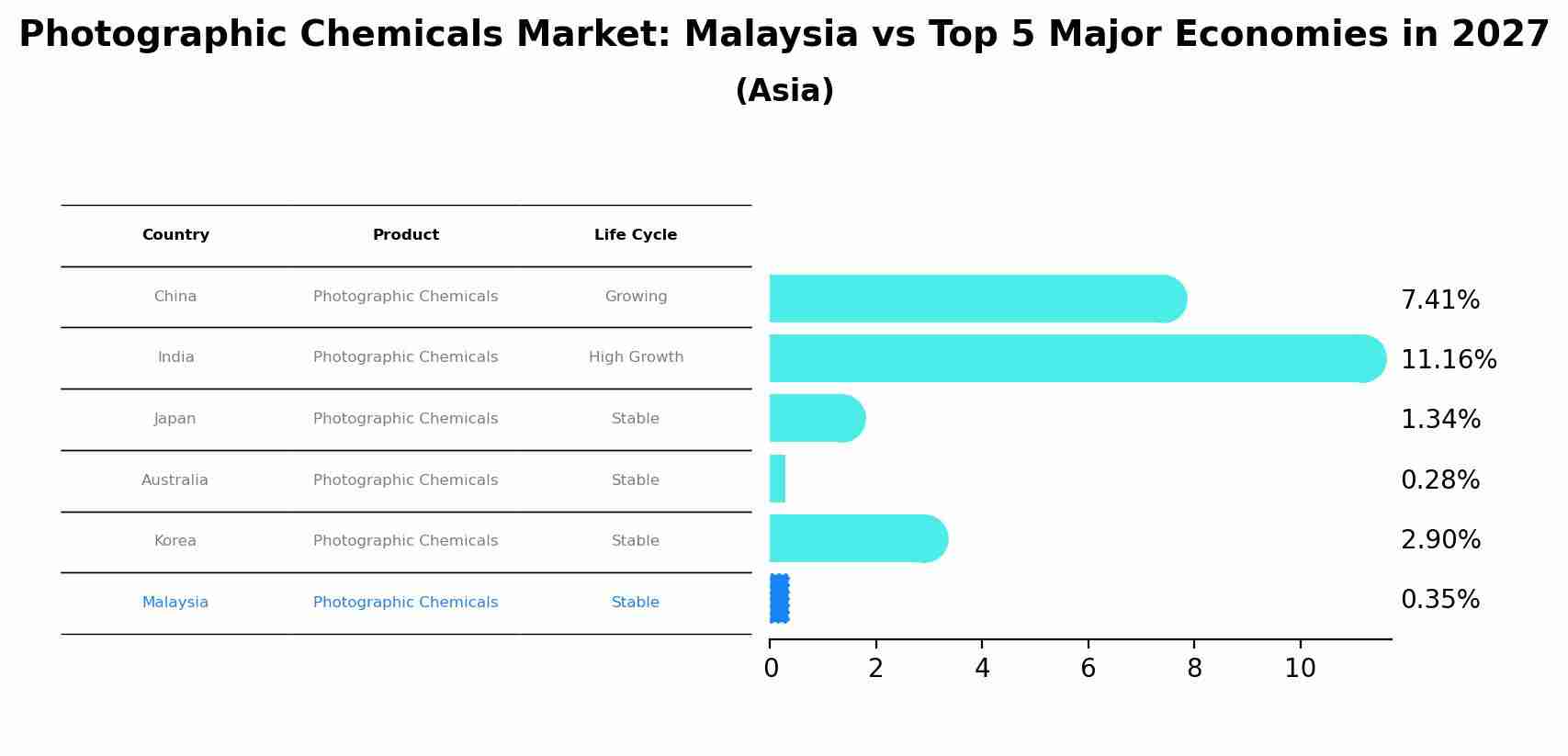Malaysia Photographic Chemicals Market (2025-2031) Outlook | Share, Analysis, Companies, Value, Forecast, Size, Industry, Revenue, Growth & Trends
| Product Code: ETC236366 | Publication Date: Aug 2022 | Updated Date: Aug 2025 | Product Type: Market Research Report | |
| Publisher: 6Wresearch | Author: Ravi Bhandari | No. of Pages: 75 | No. of Figures: 35 | No. of Tables: 20 |
Malaysia Photographic Chemicals Market Size Growth Rate
The Malaysia Photographic Chemicals Market is likely to experience consistent growth rate gains over the period 2025 to 2029. From 0.28% in 2025, the growth rate steadily ascends to 0.48% in 2029.

Photographic Chemicals Market: Malaysia vs Top 5 Major Economies in 2027 (Asia)
By 2027, the Photographic Chemicals market in Malaysia is anticipated to reach a growth rate of 0.35%, as part of an increasingly competitive Asia region, where China remains at the forefront, supported by India, Japan, Australia and South Korea, driving innovations and market adoption across sectors.

Malaysia Photographic Chemicals Market Synopsis
The photographic chemicals market in Malaysia has been significantly affected by the digital revolution in photography. With the widespread adoption of digital cameras and smartphones, the demand for traditional photographic chemicals has declined. However, niche markets, such as film photography enthusiasts and professional photographers, still sustain the demand for these chemicals. Manufacturers have adapted by focusing on producing high-quality, specialized products for these niche segments.
Drivers of the Market
The photographic chemicals market in Malaysi has niche opportunities in the market, such as the demand for specialized photographic chemicals in the film preservation and restoration industry. Additionally, the use of photographic chemicals in scientific research and medical imaging remains a significant driver. Adaptation to changing technologies and markets will be crucial for the industry`s survival.
Challenges of the Market
The photographic chemicals market in Malaysia encounters challenges due to the declining demand for traditional photography. With the digital age, there has been a significant shift away from film-based photography, leading to reduced demand for photographic chemicals. This trend necessitates adaptation and diversification within the industry to cater to niche markets or transition towards digital imaging solutions. Proper disposal and handling of photographic chemicals also pose environmental concerns, necessitating adherence to stringent regulations.
COVID 19 Impact on the Market
The COVID-19 pandemic brought challenges to the photographic chemicals market in Malaysia. With restrictions on travel and gatherings, photography-related activities declined. This impacted the demand for photographic chemicals used in film and digital photography. The market is expected to gradually recover as events and tourism rebound, but the transition to digital photography may continue to affect the long-term outlook of this industry.
Key Players in the Market
to have historically been prominent in the photographic chemicals market. However, this market has been significantly impacted by the shift to digital photography.
Key Highlights of the Report:
- Malaysia Photographic Chemicals Market Outlook
- Market Size of Malaysia Photographic Chemicals Market, 2024
- Forecast of Malaysia Photographic Chemicals Market, 2031
- Historical Data and Forecast of Malaysia Photographic Chemicals Revenues & Volume for the Period 2021-2031
- Malaysia Photographic Chemicals Market Trend Evolution
- Malaysia Photographic Chemicals Market Drivers and Challenges
- Malaysia Photographic Chemicals Price Trends
- Malaysia Photographic Chemicals Porter's Five Forces
- Malaysia Photographic Chemicals Industry Life Cycle
- Historical Data and Forecast of Malaysia Photographic Chemicals Market Revenues & Volume By Type for the Period 2021-2031
- Historical Data and Forecast of Malaysia Photographic Chemicals Market Revenues & Volume By Acetic Acid for the Period 2021-2031
- Historical Data and Forecast of Malaysia Photographic Chemicals Market Revenues & Volume By Cadmium Bromide for the Period 2021-2031
- Historical Data and Forecast of Malaysia Photographic Chemicals Market Revenues & Volume By Silver Bromide for the Period 2021-2031
- Historical Data and Forecast of Malaysia Photographic Chemicals Market Revenues & Volume By Sodium Sulphide for the Period 2021-2031
- Historical Data and Forecast of Malaysia Photographic Chemicals Market Revenues & Volume By Selenium Dioxide for the Period 2021-2031
- Historical Data and Forecast of Malaysia Photographic Chemicals Market Revenues & Volume By Others for the Period 2021-2031
- Historical Data and Forecast of Malaysia Photographic Chemicals Market Revenues & Volume By End-user for the Period 2021-2031
- Historical Data and Forecast of Malaysia Photographic Chemicals Market Revenues & Volume By Consumer for the Period 2021-2031
- Historical Data and Forecast of Malaysia Photographic Chemicals Market Revenues & Volume By Business for the Period 2021-2031
- Malaysia Photographic Chemicals Import Export Trade Statistics
- Market Opportunity Assessment By Type
- Market Opportunity Assessment By End-user
- Malaysia Photographic Chemicals Top Companies Market Share
- Malaysia Photographic Chemicals Competitive Benchmarking By Technical and Operational Parameters
- Malaysia Photographic Chemicals Company Profiles
- Malaysia Photographic Chemicals Key Strategic Recommendations
Frequently Asked Questions About the Market Study (FAQs):
1 Executive Summary |
2 Introduction |
2.1 Key Highlights of the Report |
2.2 Report Description |
2.3 Market Scope & Segmentation |
2.4 Research Methodology |
2.5 Assumptions |
3 Malaysia Photographic Chemicals Market Overview |
3.1 Malaysia Country Macro Economic Indicators |
3.2 Malaysia Photographic Chemicals Market Revenues & Volume, 2021 & 2031F |
3.3 Malaysia Photographic Chemicals Market - Industry Life Cycle |
3.4 Malaysia Photographic Chemicals Market - Porter's Five Forces |
3.5 Malaysia Photographic Chemicals Market Revenues & Volume Share, By Type, 2021 & 2031F |
3.6 Malaysia Photographic Chemicals Market Revenues & Volume Share, By End-user, 2021 & 2031F |
4 Malaysia Photographic Chemicals Market Dynamics |
4.1 Impact Analysis |
4.2 Market Drivers |
4.2.1 Growth in the photography industry in Malaysia |
4.2.2 Increasing demand for high-quality photographic chemicals |
4.2.3 Technological advancements leading to the development of innovative photographic chemicals |
4.3 Market Restraints |
4.3.1 Environmental regulations impacting the production and use of photographic chemicals |
4.3.2 Competition from digital photography reducing the demand for traditional photographic chemicals |
4.3.3 Fluctuating raw material prices affecting the cost of production |
5 Malaysia Photographic Chemicals Market Trends |
6 Malaysia Photographic Chemicals Market, By Types |
6.1 Malaysia Photographic Chemicals Market, By Type |
6.1.1 Overview and Analysis |
6.1.2 Malaysia Photographic Chemicals Market Revenues & Volume, By Type, 2021-2031F |
6.1.3 Malaysia Photographic Chemicals Market Revenues & Volume, By Acetic Acid, 2021-2031F |
6.1.4 Malaysia Photographic Chemicals Market Revenues & Volume, By Cadmium Bromide, 2021-2031F |
6.1.5 Malaysia Photographic Chemicals Market Revenues & Volume, By Silver Bromide, 2021-2031F |
6.1.6 Malaysia Photographic Chemicals Market Revenues & Volume, By Sodium Sulphide, 2021-2031F |
6.1.7 Malaysia Photographic Chemicals Market Revenues & Volume, By Selenium Dioxide, 2021-2031F |
6.1.8 Malaysia Photographic Chemicals Market Revenues & Volume, By Others, 2021-2031F |
6.2 Malaysia Photographic Chemicals Market, By End-user |
6.2.1 Overview and Analysis |
6.2.2 Malaysia Photographic Chemicals Market Revenues & Volume, By Consumer, 2021-2031F |
6.2.3 Malaysia Photographic Chemicals Market Revenues & Volume, By Business, 2021-2031F |
7 Malaysia Photographic Chemicals Market Import-Export Trade Statistics |
7.1 Malaysia Photographic Chemicals Market Export to Major Countries |
7.2 Malaysia Photographic Chemicals Market Imports from Major Countries |
8 Malaysia Photographic Chemicals Market Key Performance Indicators |
8.1 Adoption rate of digital photography in Malaysia |
8.2 Investment in research and development for new photographic chemicals |
8.3 Environmental sustainability practices implemented by photographic chemical manufacturers |
9 Malaysia Photographic Chemicals Market - Opportunity Assessment |
9.1 Malaysia Photographic Chemicals Market Opportunity Assessment, By Type, 2021 & 2031F |
9.2 Malaysia Photographic Chemicals Market Opportunity Assessment, By End-user, 2021 & 2031F |
10 Malaysia Photographic Chemicals Market - Competitive Landscape |
10.1 Malaysia Photographic Chemicals Market Revenue Share, By Companies, 2024 |
10.2 Malaysia Photographic Chemicals Market Competitive Benchmarking, By Operating and Technical Parameters |
11 Company Profiles |
12 Recommendations |
13 Disclaimer |
- Single User License$ 1,995
- Department License$ 2,400
- Site License$ 3,120
- Global License$ 3,795
Search
Thought Leadership and Analyst Meet
Our Clients
Related Reports
- Afghanistan Apparel Market (2026-2032) | Growth, Outlook, Industry, Segmentation, Forecast, Size, Companies, Trends, Value, Share, Analysis & Revenue
- Canada Oil and Gas Market (2026-2032) | Share, Segmentation, Value, Industry, Trends, Forecast, Analysis, Size & Revenue, Growth, Competitive Landscape, Outlook, Companies
- Germany Breakfast Food Market (2026-2032) | Industry, Share, Growth, Size, Companies, Value, Analysis, Revenue, Trends, Forecast & Outlook
- Australia Briquette Market (2025-2031) | Growth, Size, Revenue, Forecast, Analysis, Trends, Value, Share, Industry & Companies
- Vietnam System Integrator Market (2025-2031) | Size, Companies, Analysis, Industry, Value, Forecast, Growth, Trends, Revenue & Share
- ASEAN and Thailand Brain Health Supplements Market (2025-2031) | Strategy, Consumer Insights, Analysis, Investment Trends, Opportunities, Growth, Size, Share, Industry, Revenue, Segments, Value, Segmentation, Supply, Forecast, Restraints, Outlook, Competition, Drivers, Trends, Demand, Pricing Analysis, Competitive, Strategic Insights, Companies, Challenges
- ASEAN Bearings Market (2025-2031) | Strategy, Consumer Insights, Analysis, Investment Trends, Opportunities, Growth, Size, Share, Industry, Revenue, Segments, Value, Segmentation, Supply, Forecast, Restraints, Outlook, Competition, Drivers, Trends, Demand, Pricing Analysis, Competitive, Strategic Insights, Companies, Challenges
- Europe Flooring Market (2025-2031) | Outlook, Share, Industry, Trends, Forecast, Companies, Revenue, Size, Analysis, Growth & Value
- Saudi Arabia Manlift Market (2025-2031) | Outlook, Size, Growth, Trends, Companies, Industry, Revenue, Value, Share, Forecast & Analysis
- Uganda Excavator, Crane, and Wheel Loaders Market (2025-2031) | Strategy, Consumer Insights, Analysis, Investment Trends, Opportunities, Growth, Size, Share, Industry, Revenue, Segments, Value, Segmentation, Supply, Forecast, Restraints, Outlook, Competition, Drivers, Trends, Demand, Pricing Analysis, Competitive, Strategic Insights, Companies, Challenges
Industry Events and Analyst Meet
Whitepaper
- Middle East & Africa Commercial Security Market Click here to view more.
- Middle East & Africa Fire Safety Systems & Equipment Market Click here to view more.
- GCC Drone Market Click here to view more.
- Middle East Lighting Fixture Market Click here to view more.
- GCC Physical & Perimeter Security Market Click here to view more.
6WResearch In News
- Doha a strategic location for EV manufacturing hub: IPA Qatar
- Demand for luxury TVs surging in the GCC, says Samsung
- Empowering Growth: The Thriving Journey of Bangladesh’s Cable Industry
- Demand for luxury TVs surging in the GCC, says Samsung
- Video call with a traditional healer? Once unthinkable, it’s now common in South Africa
- Intelligent Buildings To Smooth GCC’s Path To Net Zero


















